Sunday, 6 June 2004
Distance 23 km
Duration 6 hours 25 minutes
Ascent 329 m, descent 1297 m
Map 65 in the TOP 100 blue series (now superseded)
Topoguide (ref 716) Traversée du Haut-Languedoc
Just because we could, we had another shower in the morning, then ate our muesli and stepped downstairs for coffee at the bar. We knew that we had an enormous descent ahead of us, but the track started with a long easy upward stretch, along the stream and then into the forest, where a brown mattress of dead leaves gave a spring to our steps. It was pleasant but puzzling.
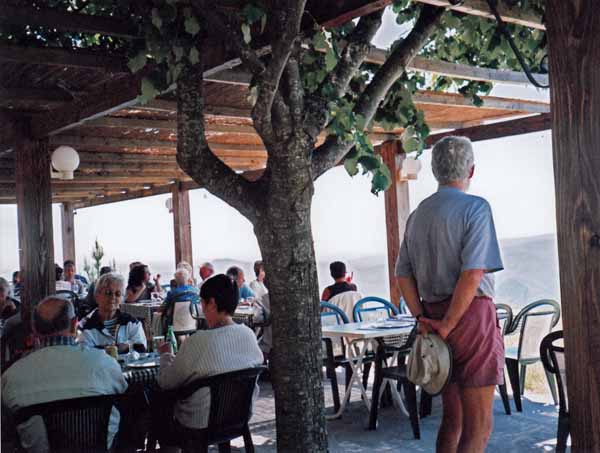
When the downhill came it did so with a vengeance and the cushioned track became a channel of loose boulders, dry now but obviously a watercourse in times of rain. Our progress became slow.
After a while, mentally and physically wrung out, we sat on a rock and had our lunch, and soon after we crossed the road, also descending but not as drastically as we were.
Another forest way took us abruptly down to a knoll, then to another bend of the road. Here, as if by divine intervention, appeared a large restaurant (la Cravate) serving lunches on a wide, vine-covered terrace overlooking the valley.
The tables were full of well-dressed elderly ladies surrounded by their families. Bunches of flowers were much in evidence – it was le Fête des Mères, the French Mothers’ Day. The harrassed but smiling waitress showed us to a small table at one side for our cafés crèmes, which were all the more delightful for being unexpected.
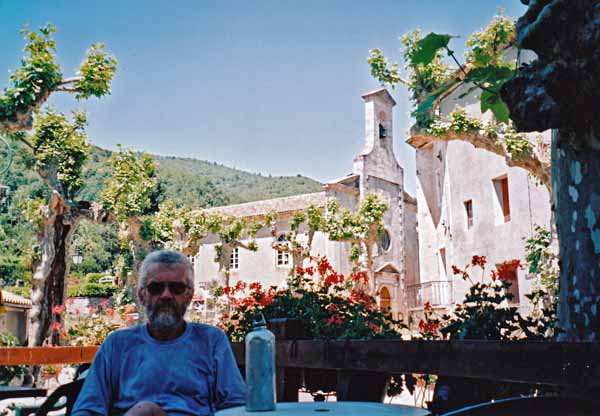
Greatly refreshed, we took to the track again, which had become much solider underfoot, one of the meticulously paved throughfares laid down scores of generations ago and still a pleasure to walk on.
The large flat surfaces of the stones are only the top faces of deeply buried boulders, which explains why these old ways have lasted so well.
As we bounded down, we met a happy party of walkers with day packs coming up. It is rare for us to see other walkers and we are always pleased to stop for a chat. One of them was so keen to instruct us where to go that it was hard to bring the conversation to a close.
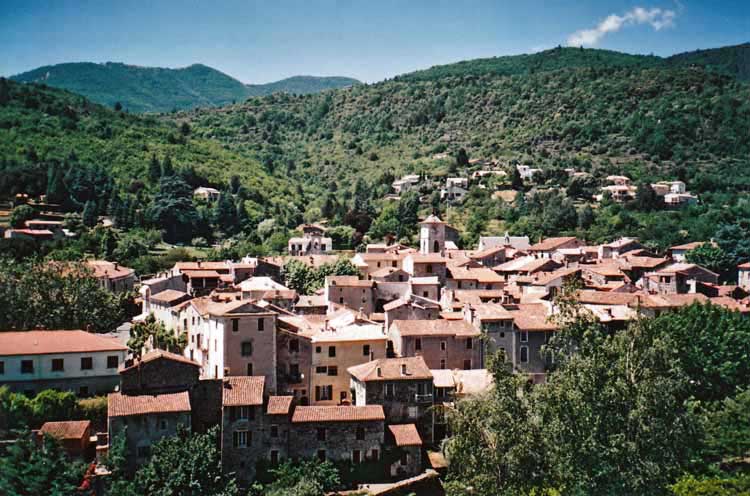
Descending further, past the ruined hamlet of Pratcoustals, we had another pleasant meeting, this time with several cherry trees laden with fruit. We had not had any wayside snacks for weeks – the mountains were far too cold.
At Aulas, a village of flowers, we sat down on the terrace of a closed café and took off our boots. There was an open bar nearby but we were already well caffeinated.
Over the bridge and along a narrow, trampled path, we looked down on the conglomeration of le Vigan, and after a long, steep scramble we arrived at the central square.
A vintage car rally was under way but little else, and we were not best pleased to see the sign saying “Camping 2 km” pointing east. Given that our direction lay south towards Avèze, which was only 2 km away and had a camping ground of its own, we decided to press on.
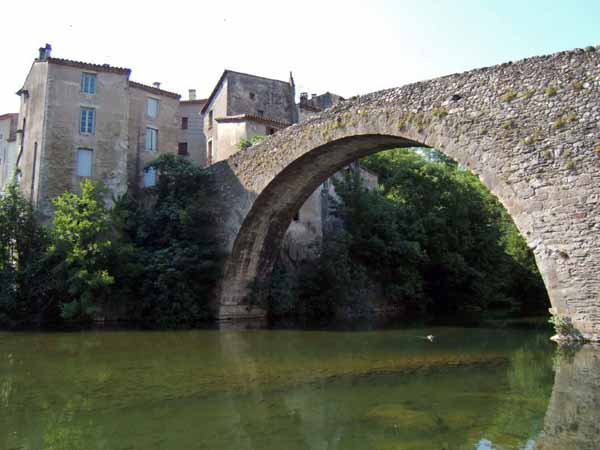
The walk along the river bank proved delightful after our exertions in the mountains, a smooth gravel promenade edged with lawns and seats. We were soon in Avèze.
A sign to the camping ground led only to a sports field, so we decided to look for it later, after having checked the eating potential of the village.
We crossed the river on the old footbridge and wandered into the desultory Sunday afternoon town. A group of youths hanging about a carpark eagerly told us how to get to the bar, up a flight of stairs from the next street, and even walked with us to the base of the steps, with impressive Gallic courtesy.
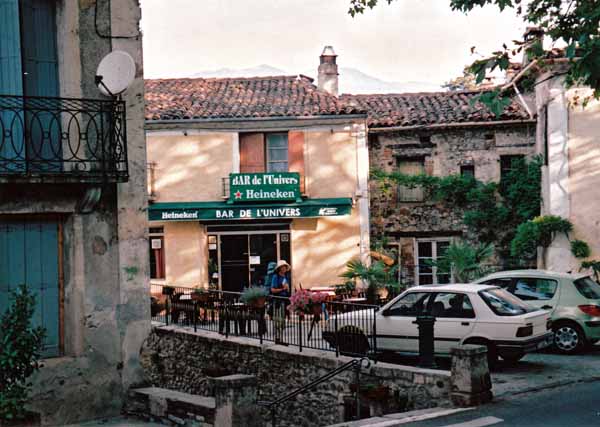
The sight of sun umbrellas on a terrace never fails to delight us and we sat down joyfully under one of them and ordered beers. A doll-like woman in a miniskirt, the owner of the bar, had been sitting at another table, reading a book in English.
When she brought our drinks there ensued one of those strange but entertaining conversations in which each person speaks laboriously in the other’s native language, determined not to take the easy way out and revert to their own.
She said that there was a hotel-restaurant next door, not very nice, too expensive and possibly not open this evening, and that the people who ran it were horrible – it was a glimpse into the joys of village life that visitors do not usually see.
There was only one eatery in town, however, so I went next door and rang the doorbell. A doggy little man with a grey walrus moustache appeared and assured me that we could eat there. Then I sat at the bar and minded the packs while Keith wandered down to look for the missing camping ground.
He found it next to the sports field behind a hedge, but it was a ghost of its former self, locked and abandoned, with the taps cut off the wall. Nevertheless we decided to sleep there, our only slight worry being that the hotel people would wonder where we were staying. We felt it was probably illegal to stay in a closed camping ground.
After a quick wash-up in the dingy toilets at the bar, we presented ourselves at the hotel, where tables were now set up in the gravelled courtyard, their pink tablecloths matched by the climbing roses leaning out from the wall. The building was charming and rather old, although not compared to the eleventh-century chateau across the road.
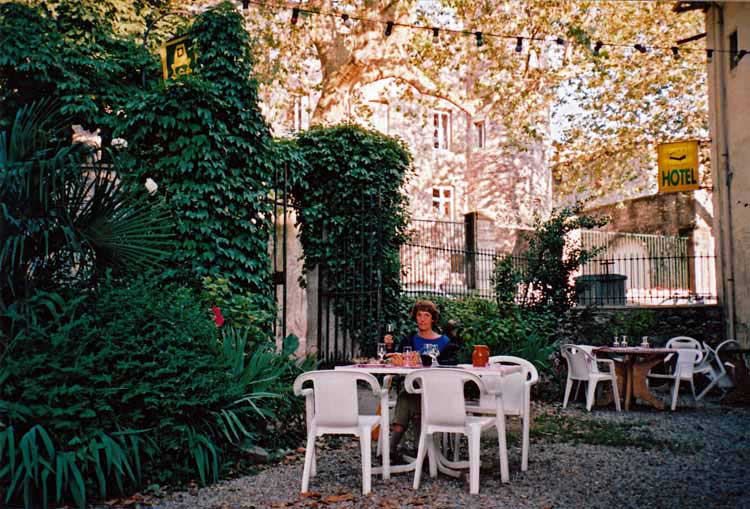
Our hostess was a shapeless middle-aged woman and as we feared, she was very inquisitive about where we intended to stay.
I lied that we were going to le Vigan, and she wanted to know which hotel, so I became vague. Meanwhile some other guests had arrived.
A pasty old fellow swept into the courtyard in a BMW sports car and crunched to a halt next to his habitual table – he was a German expatriate living in the village. An even pastier old woman at another table turned out to be a local Englishwoman.
She had ordered some fish and wanted to know the English translation of its name. The German fellow came over to help, so did we, and the chef with the walrus whiskers emerged with a large culinary encyclopedia full of pictures of fish. The matter was never resolved, but we all enjoyed trying. Then we dispersed to our own tables and the plummy-voiced Englishwoman ate her fish, washing it down with a full bottle of champagne.
We chose the menu for €13 each, which did not seem exorbitant, despite the barwoman’s dark warnings. First we had large salads embellished with ham and Auvergne blue cheese, then skewers of lamb with rosemary and an array of cooked vegetables. Both of these courses slipped down beautifully and so did a couple of baskets of bread. To finish we had chestnut icecream made on the premises.
Our nosy waitress kept pressing us about where we were staying. She could smell a possible customer for a room. We had no intention of satisfying her curiosity, but we had to admit that we had no hotel booked in le Vigan. She offerred to ring one of them for us, but we hastily declined and set off into the gathering dusk with a wave. The derelict camping ground was spooky and I felt that we would be discovered, or molested, but of course we weren’t.
Previous day: L’Hospitalet to L’Espérou